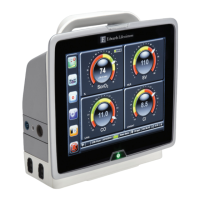216
HemoSphere Advanced Monitor F System Care, Service and Support
F.6 Monitor Disposal
To avoid contaminating or infecting personnel, the environment or other equipment, make sure the
HemoSphere advanced monitor and/or cables are disinfected and decontaminated appropriately in
accordance with your country's laws for equipment containing electrical and electronic parts prior to
disposal.
For single use parts and accessories, where not otherwise specified, follow local regulations regarding
disposal of hospital waste.
F.6.1 Battery Recycling
Replace the HemoSphere battery pack when it no longer holds a charge. After removal, follow your local
recycling guidelines.
CAUTION Recycle or dispose of the lithium-ion battery in accordance to all federal, state, and local
laws.
F.7 Preventive Maintenance
Periodically examine the HemoSphere advanced monitor exterior for general physical condition. Make sure
the housing is not cracked, broken or dented, and that everything is present. Make sure there is no sign of
spilled liquids or signs of abuse.
Routinely inspect cords and cables for fraying and cracks, and make sure there are no exposed conductors.
F.7.1 Battery Maintenance
F.7.1.1 Battery Conditioning
The battery pack may require periodic conditioning. This feature should only be performed by trained
hospital staff or technicians. Refer to the HemoSphere advanced monitor service manual for conditioning
instructions.
WARNING Explosion Hazard! Do not open battery, dispose of in fire, store at high temperature
or short circuit. It may ignite, explode, leak or get hot, causing serious personal injury
or death.
F.7.1.2 Battery Storage
The battery pack can remain stored in the HemoSphere advanced monitor. Refer to “HemoSphere
Advanced Monitor Specifications” on page 190 for environmental specifications for storage.
NOTE Long term storage at high temperatures may decrease life of battery pack.
Status = Released Printed Date: 2018-01-16 Released Date: 2017-09-14

